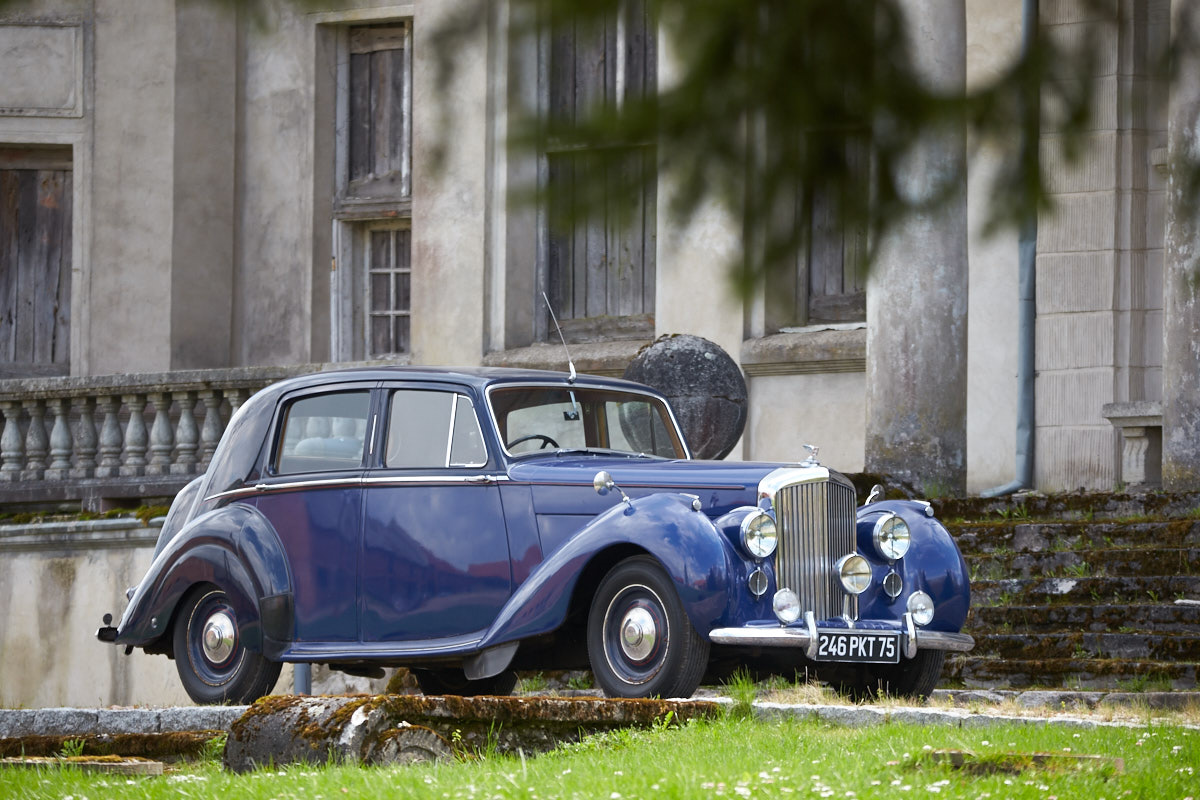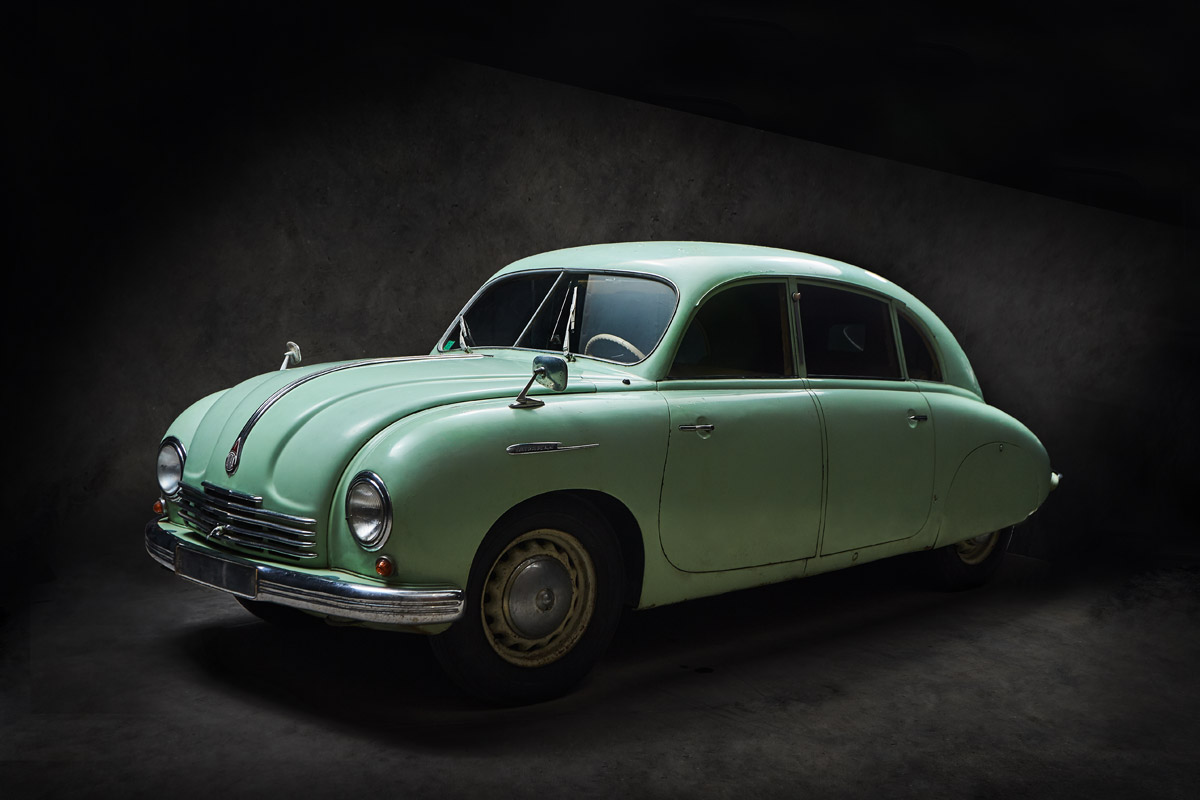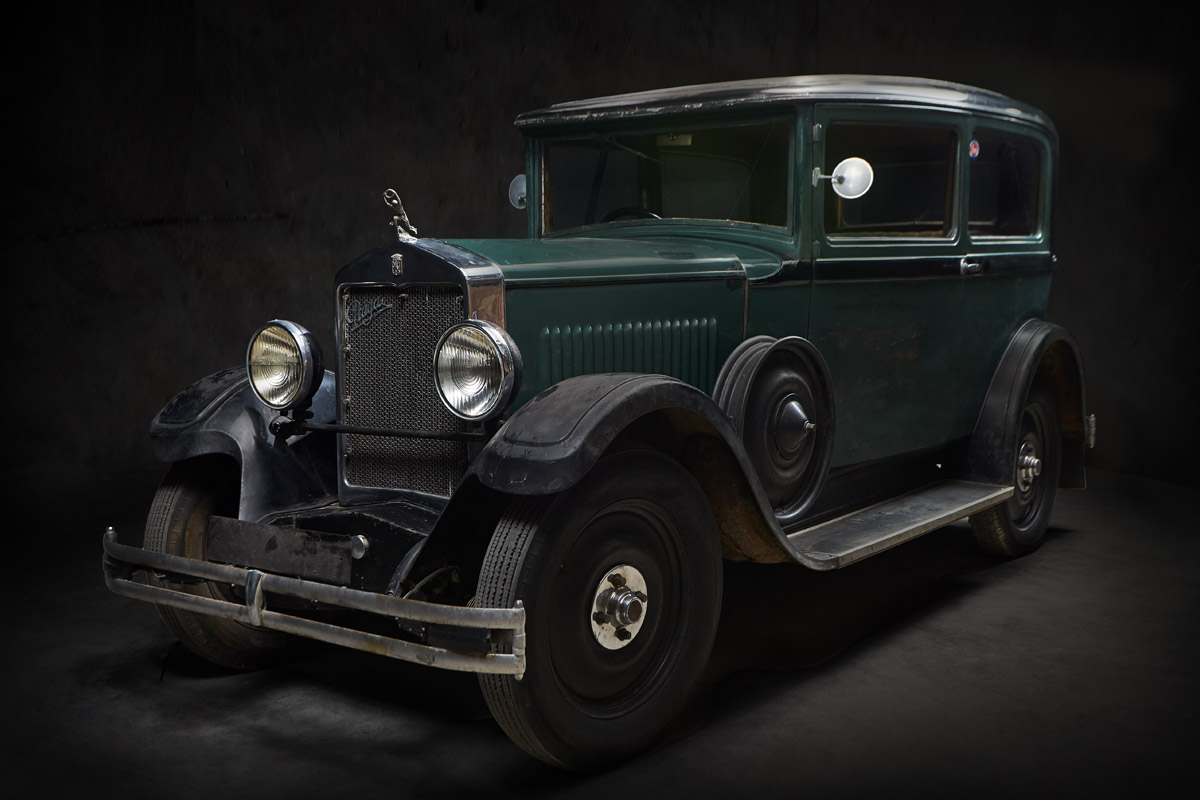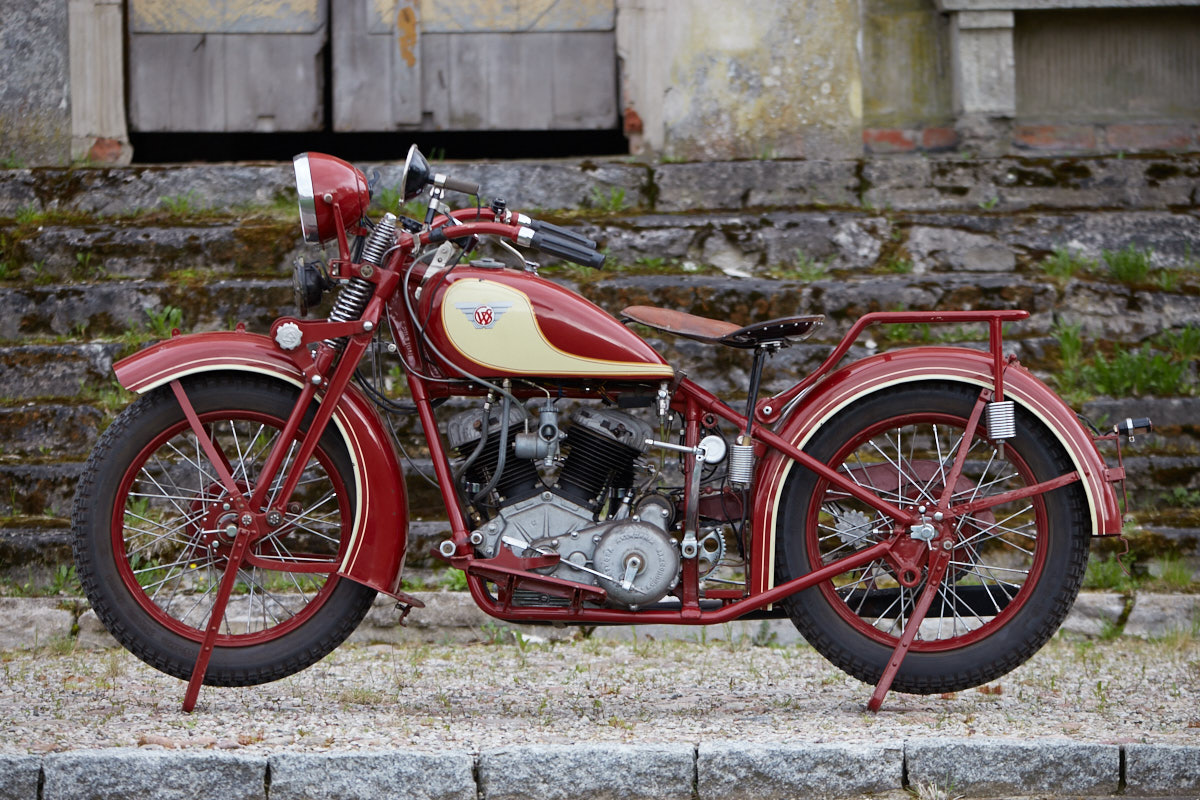 Muzeum Biała Olecka 9, tel.: 503 927 590
Muzeum Biała Olecka 9, tel.: 503 927 590
 Muzeum Biała Olecka 9, tel.: 503 927 590
Muzeum Biała Olecka 9, tel.: 503 927 590![]()
Here is the first model in Bentley’s post-war history – the Mark VI with a 4 ½-litre designation, which, of course, gives away the capacity of its six-cylinder engine running with the utmost culture. Bentleys have never been cheap; indeed, they have always been expensive. The brand’s splendour was established at the very beginning, when the crazy and passionate racing driver Walter O. Bentley began to create strong, powerful and robust tourers that soon dominated the famous Le Mans races. After financial difficulties, the brand was taken over by Rolls-Royce in 1931, and from that moment, all models have been produced in one factory, the famous Crewe (where the Bentleys are still made in a modern factory).
The brand supplied the perfectly made chassis with a drive unit, while the bodywork was done by external companies so that the final finishing of the car (also as to the bodywork version) was dictated only by the imagination and resources of the client. And these were neither limited by the former, nor did they begrudge the latter – one French customer, for example, wanted his upholstery made from the skins of Philippine frogs. In six years, 5,208 units of Mark VI were produced.


This small Czechoslovak car factory lasted only 18 years, ending its story during the period of industry nationalisation in 1947. The founder of Aero started his business by producing sidecars for motorcycles before he bought back a nearly-finished design for a small car. After numerous modifications, he released his first Aero 500 with a single-cylinder engine producing barely 10 hp. However, these tiny and spartan designs gained popularity even in the rally events of the time. Above all, they were charming little cars with an elegant silhouette. The model on display is already the second version of the Type 20 (also called the Aero 660), with a „serious” two-cylinder engine with 18 hp and four-wheel brakes, as the 500 model only had rear axle braking system.
![]()
This model’s silhouette seems to predate the period in which it debuted. The Tatraplan derives from the Czechoslovak manufacturer’s pre-war line of luxury aerodynamic cars. Although it debuted as early as the late 1940s, it was not stylistically inferior to its competitors two decades younger (with an air drag coefficient of Cx 0.32, shockingly low for that period). A symbol of the Tatra is the air-cooled rear engine, the one here being a two-litre boxer. A fun fact is that to balance out the weight of the heavy rear and improve driving, a battery, a 56-litre fuel tank, and two spare wheels were all placed under the bonnet.
The question now is, where did this bizarre model name come from? Well, the second part of the name was added to refer to the two-year plan for rebuilding the Czechoslovak economy after the war ended. When the communists came into power, the Tatra was withdrawn from free sale. It was available only for the authorities and state-owned enterprises. However, it was exported abroad on the free market. In this way, 97 cars appeared in Poland. The exhibit from the museum’s collection was owned by the wife of the Czechoslovak ambassador in Paris.


If a car model is an exhibit at the Museum of Modern Art in New York, then one knows it is an icon. Indeed, the Jaguar E-type is a design icon. Enzo Ferrari himself, at the sight of it, said that it was the most beautiful car that had ever been produced. The E-type was first shown to the world on 15 March 1961 at Geneva Motor Show. However, the already announced launch would almost not have happened since the car was still being fine-tuned in the Coventry factory the day before. At 7 p.m. Jaguar’s crazy chief of marketing, Bob Berry, got into the just-finished prototype and raced to the ferry so as to get to the continent and on to Geneva. That night, in the rain, he drove 600 miles in 11 hours! He arrived at the exhibition halls 20 minutes before they opened to the media and industry people. They didn’t even have time to clean the car properly, but all the same, it became the sensation of the event. No car could offer such looks and performance for such an affordable price. The result was that the celebrity world went wild with it and the model itself remained in production for the next 14 years. The E-type in the collection is from Series II, with the so-called 2+2 seating arrangement, coupe body, and the iconic sporty 4.2-litre six-cylinder engine.
If it were not for the famous “Back to the Future” film, no one would remember the DeLorean DMC-12 by now. It was a failure even before it was produced. And yet, it still has its place in the pop culture. John DeLorean was an engineer who made his career at General Motors, rising all the way to the position of vice president. When leaving the company in 1973, he had ambitions to create his own sports car. After difficult negotiations, he cut a deal with… the British government, which supported production at a factory set up in Ireland. However, the whole undertaking could be analysed nowadays in economics lessons as an example that should never be repeated: poor planning, financing and design with an admixture of irrational dreams. The result was that the whole project was about saving the work that had been started. The initiated works were taken over by Lotus and several variants of the V6 engine and transmissions from various brands were tested. Giugiaro designed a weird wedge-shaped body with a gull-wing door. Panels of polished stainless steel were attached to the fibreglass structure. And on top of that, DeLorean insisted on an engine behind the rear axle. The car looked faster than it could go. Add quality issues, the withdrawal of the British government funding and increasing debts, and after only 8 months of production and 8,000 cars released, the definitive end was in sight. Interestingly, the search for new car buyers continued for years. By contrast, things were quite the opposite in the pop culture. A director, Robert Zemeckis, used this futuristic-looking car in the film “Back to the Future” to transfer the characters in time. And so the iconic film gave immortality and fame to… the infamous car.


“Baroque angel” – that was the nickname of this beautiful model whose bodywork added quite a bit of chic during its premiere at the 1951 Frankfurt Motor Show. Interestingly, the chief stylist of BMW models, Peter Schimanowski, had Polish origins. It was he who added the distinctive grills at the front of BMWs that have been preserved up to now, and who created the 501 model. That was the first post-war BMW vehicle. The company, which today is synonymous with luxury cars, was not in good shape at that time, so to rebuild its pre-war position, it decided to launch a luxurious saloon (although there were also coupe and convertible variants), which could somewhat confound competitors. Unfortunately, the engines used initially turned out to be too weak (they needed 27s to reach 100km/h) and the model itself was so expensive that in the first sales year only 190 cars were sold. Two years after its debut, a 2.6-litre V8 engine was introduced, making the model the fastest saloon manufactured in Germany.
![]()
The representative ZIL was produced exclusively for the needs of the Soviet Union’s party and state apparatus, so it was not offered for sale to the general public. Until the death of Stalin, ZiL limousines were known under the name of ZiS (acronym for the Stalin Plant – Zavod Imeni Stalina). Then, in 1956, they were renamed to commemorate the former director of the factory, Ivan Likhachov. The model 41045 displayed in the collection was manufactured only for two years (106 cars were assembled), and, like its predecessors, it was largely based on the American limousines dedicated to leaders. Its monumental silhouette can overwhelm one with its size. It’s 2.1 m wide and 6.34 m long. Its interior was supposed to be comfortable for driving in every dimension. Models from the mid-1980s served in the cabinet of Mikhail Gorbachev, who became president in 1990. He also used an open-body version for state parades and special occasions. The model on display was purchased from the state structures by a private person after it had been withdrawn from the service. Three years ago, the owner of the museum in Biała Olecka managed to reach out to the owner of the car and buy it, driving it himself from Moscow. When he succeeded in obtaining „permission for an object important to state history to leave Russian territory permanently”, officials commented on the purchase by saying: „Our minister enjoyed it, now it’s yours”.


Today, the “ Praga “ car is mainly associated with a large
truck with a specialised body. But this was not always the case. The factory produced quite a lot of passenger cars, including the successful Piccolo models. These had several bodywork variants and engine versions, including a 1-litre engine. The vehicles had a reputation for durability and strength. Since 1929 a Polish-Czech company in Oświęcim produced the Praga Piccolo. It was actually more of an assembly operation than a production. Several hundred Piccolos, highly acclaimed in the country, were assembled there until World War II.
A fun fact: the original Piccolo from the United Machine and Car Factories Oświęcim-Praga are today exceptionally rare, fetching prices much higher than the surviving vehicles of Czech production.
In the late 1980s and early 1990s, Volvo saloons were synonymous with unrestrained elegance, safety, and durability. Not surprisingly, they were seen as representative cars. The first Volvo limousine was already purchased during the presidency of Wojciech Jaruzelski, and it was later „inherited” by President Lech Wałęsa. The car was later used by Prime Minister Hanna Suchocka when she assumed this post in 1992. The extended limousine had, among other things, armoured windows three centimetres thick and a plate under the chassis to protect the car from explosion. Interestingly, after the vehicle was withdrawn from political service, it ended up in the police and was used to drive… crown witnesses.


The WUL-GUM motorcycle belongs to a little-known history of Polish single-track vehicles. This is not surprising since the Poznań-based WUL-GUM company was not an independent motorcycle manufacturer but only an assembly plant for the components imported mainly from Germany (the plant operated n in 1937-39). The important fact is that the finished motorbikes were sold as Polish. It was a solution more convenient for the entrepreneur since in this way the vehicles were exempt from the 20% tax paid on the purchase of imported motorcycles. So officially, although made abroad, it became a domestic product. Only a few motorbikes of this kind were preserved to this day.






